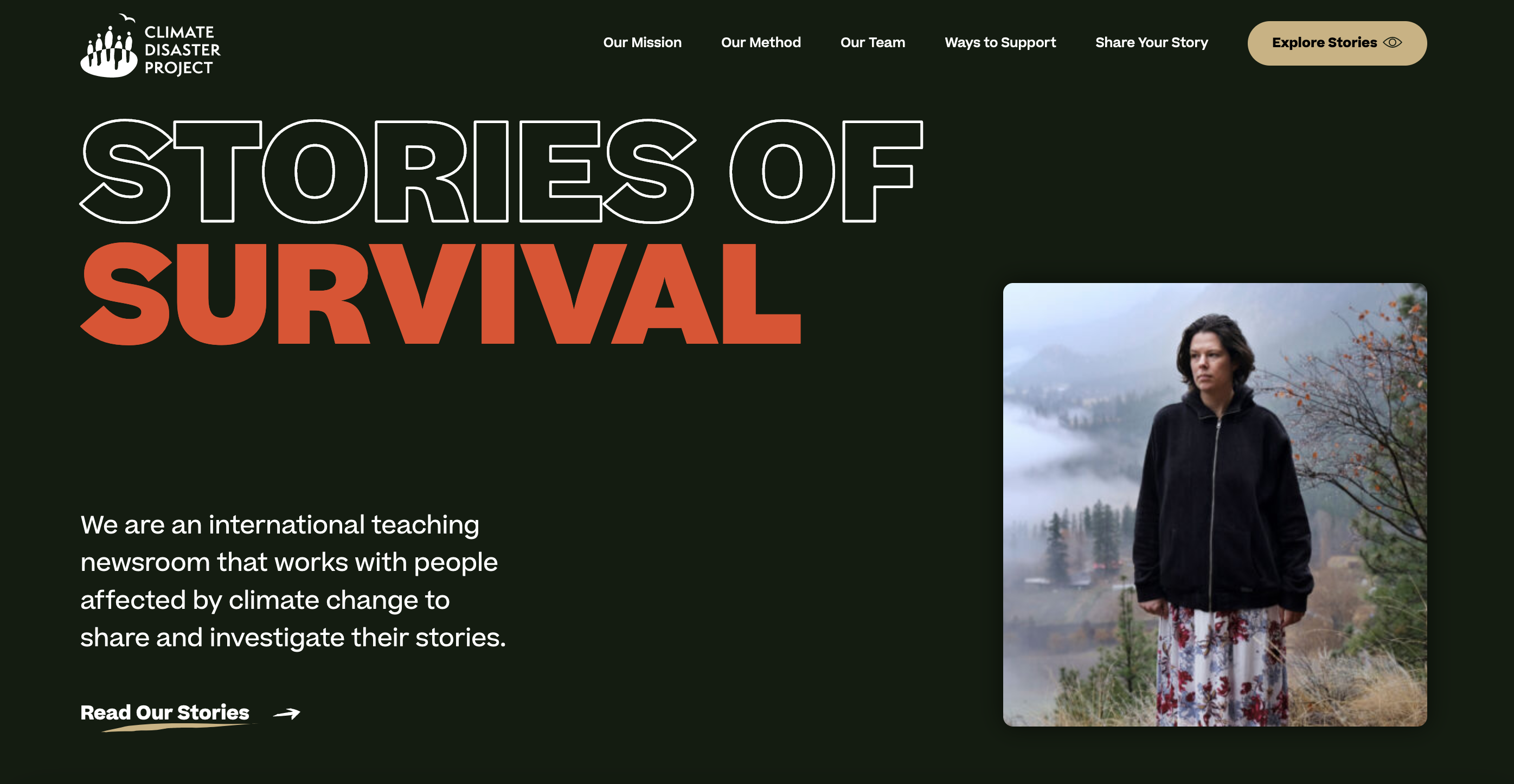Amplifying the stories of survivors of climate-related disasters
While it almost feels routine now, 2017 was a year marked by environmental disasters. Fire ripped through interior British Columbia and blanketed the lower mainland in smoke. Drought killed cattle and crops in Alberta and flooding destroyed homes in Quebec and Ontario.
Watching news coverage, journalism professor Sean Holman, who at the time was teaching at Mount Royal University in Calgary, felt frustrated. News outlets had the same interest in natural disasters as they always had, but few were linking these increasingly dramatic human stories to climate change, even though scientific evidence to support this link was clear.
The stories he saw were often focusing on the single weather events, without making a connection to the changing climate or highlighting the impact of such events on individuals and communities.
“In the past, journalists and activists and governments have treated (climate change) as a sort of future tense, large-scale issue, rather than a present tense human-scale issue,” explains Holman, who is now Wayne Crookes Professor of Environmental and Climate Journalism at the University of Victoria.
“If it’s a fight for flora and fauna, as opposed to people in their day-to-day lives, it’s no wonder that we have the kind of climate inaction you’re still seeing globally around the world.”
Holman wanted to do things differently. He wanted climate-related disaster stories to focus on the human cost of these events and highlight the experiences of survivors, then connect these to the bigger picture of man-made climate change. In 2021, he started the Climate Disaster Project – a method and course model that can be integrated into journalism courses and workshops.
The CDP resources and guidelines can be used in a variety of forms. Holman has offered a dedicated course as a co-teacher with colleagues in other institutions, led virtual courses and hosted community workshops. Educators at various journalism schools have integrated the project’s curriculum into their own courses and have been inspired by the resources.
In most cases, faculty work with students to identify survivors of climate-related disasters and use trauma-informed interviewing to document their experiences. First, students interview each other about their personal experiences with climate change. One student in Nova Scotia recalled a heat wave so intense it melted medication in bathroom cabinets and caused her onions to sprout in the pantry.
Those personal stories are then shared with disaster survivors, who are interviewed to produce both a transcript and a condensed “as-told-to” article. Each class can decide what the journalistic output looks like. Students at Mount Royal University’s journalism program recently produced a podcast series following the CDP method.
With the permission of the source, these testimonies have also formed a launching point for journalism investigations about larger issues. One interview about the impacts of smoke on the health of tree planters resulted in an investigation in The Tyee about outdoor job hazards.
Another interview with an Eskasoni First Nation emergency manager in Nova Scotia led to an in-depth story on an Indigenous-led emergency alert system published in Canada’s National Observer.
So far, over 288 testimonies have been gathered in partnership with 13 journalism programs including Carleton University, Langara College, Humber College, Mount Royal University and Toronto Metropolitan University. International partners include schools in Australia and the United States.
In April, the CDP received a special recognition from the National Newspaper Awards.
Using a trauma-informed approach
Holman says that many survivors of natural disasters are eager to share their experiences because they need someone to listen to their stories. Some seek community with people experiencing the same challenges. For others, they hope that sharing what they went through could make communities safer or lead to policy change.
Journalism is a powerful vehicle for all three goals – but trusting someone with the worst day of your life comes with a high risk, which is why Holman wants to ensure journalism students approach climate-disaster stories with an understanding of trauma.
“If we understand that trauma is a result of an extreme lack of control, then a warmer world is a more traumatic world,” explains Holman. “To understand the need for trauma-informed journalism, you have to understand just how [painful] traditional journalism can be for people who’ve experienced trauma. You need to empathize with the hurt that it can recreate,” he says.
Traditional journalism practices, such as simply asking someone to recount their traumatic story for the media, or asking for a quick comment without proper context and preparation, can harm a vulnerable source, Holman explained. Traumatized sources may be willing to share their painful story but risk being retraumatized, misrepresented or feeling a loss of control that could compound their bad experience.
University of King’s College student Eunice Abaga was drawn to trauma-informed journalism’s unique approach to interviewing people. She had been on the opposite side of the microphone before – and it wasn’t a good experience.
“I was looking for ways in which you could report authentically while respecting what that person said,” she says. “The trauma-informed perspective engages the storytellers in ways that are more in-depth compared to traditional reporting.”
Abaga interviewed two East Coast survivors of wildfires and a woman who lost her home to flash floods in 2023. Their stories were intense to listen to.
“The experience was challenging, humbling and rewarding,” she says. “It wasn’t easy. I felt as if I could feel the frustration in her voice. But the Climate Change Disaster approach is to share stories to build community, and community builds hope. The more stories we share, the more people will see the need to take action.”
Before the interviews started, the class discussed consent and how to approach questions that could trigger a survivor into a trauma response. They also talked about checking in on interviewees after talking to them and resources they could share if things got difficult for them during the interview.
University of Victoria student Kristen De Jager interviewed survivors of the 2018 wildfires in California. As a journalist, she plans to continue using those techniques to cover other issues, such as addiction and mental health.
“The story that you’re going to get is just not the same as something that you get with the trust you build with trauma-informed journalism,” she says.
By definition, trauma involves a terrible loss of control. The Centre for Addiction and Mental Health’s description notes trauma “can harm a person’s sense of safety, sense of self, and ability to regulate emotions and navigate relationships.”
In approaching an interview, journalists have an opportunity to give some control back – but it sometimes requires breaking some of the tenets of traditional news gathering.
Interviews for the CDP are only considered after six months or more have passed since the traumatic event. Questions are sent in advance and sources can change them, remove them or add new ones.
When interviews are finished, sources review the final materials and are free to make changes. They can also withdraw from the project at any time. All of this marks a departure from traditional methods.
“The problem is that journalism – to a certain extent – takes control away from people so that we can maintain our independence and ensure that we’re not biased. It creates a fundamental conflict between journalists and traumatized people,” explains Holman.
“How do you do journalism in that environment? We don’t really have good answers to that. Part of the Climate Disaster Project is about finding out what those answers look like and challenging some fundamental assumptions.”
It’s not a style of journalism that would suit every story, admits APTN journalist Rob Smith.
When APTN Investigates partnered with the Climate Disaster Project in 2022, the editorial team spent a lot of time considering if they were comfortable with the idea of providing questions beforehand.
“We decided to go ahead with it as long as we were upfront that this is a bit of a different story,” said Smith.
“We’re not going to be doing that for politicians or chiefs or whatnot. It depends on the point of the story. If it’s a hard-hitting piece where you need to be that old-fashioned journalist, then we’ll do it. There’s flexibility. You have to use your common sense,” he says.
The environment of a newsroom – particularly the constraints on a daily television broadcast – often requires clarity and speed to be the highest priorities. But Smith was curious about trying something different.
“There’s been a lot of discussion in our industry over the past 10 years in terms of how people in trauma are treated. You hear the term trauma porn thrown around,” he explains. “You have to ensure that when the story comes out, that (viewers) get a feel for who the people are. You’re not just looking at a victim. This is a real human being.”
A half-hour documentary-style program like APTN Investigates allows time to “approach with kindness; letting them tell their story. Not racing in and racing out.”
It was a good fit. Working with student journalists, the show profiled three disaster survivors in British Columbia who had experienced deadly heat waves and catastrophic wildfire evacuations in 2021.
The subjects recall intense moments, sometimes choking up at painful memories like escaping wildfire on a highway surrounded by flames. But the storytellers are also depicted as more than their trauma – as artists, family members and resilient people who are reflecting on their experiences and looking for answers.
Far from sanitizing their experiences, Holman believes the more co-operative approach can help achieve the ultimate goal of journalism.
“Journalism is often set up around the notion that you have to steal the truth in order to find it. But what would happen if instead, we thought about the truth as a gift? What if we operated from the assumption that the people we work with are just as interested in telling the truth as we are?”
Haley Ritchie has worked as a reporter and photographer for newspapers across the country as a freelancer and staffer, from Ottawa to Whitehorse. In that time she has hung from cliffs, risked camera gear in leaky rowboats and bluffed her way into fancy ballrooms in pursuit of unique stories about people, politics and the outdoors. Follow her on Twitter at @hyritchie.


